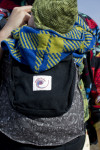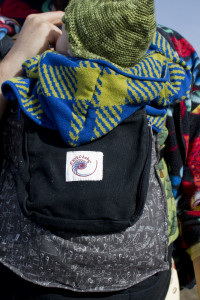More and more frequently, parents can be seen with their babies tucked snugly into cloth carriers of various types in malls, on the street, and in the home. This mode of baby travel is steadily gaining popularity and for good reason: soft carriers have proven to be a simple, practical way to incorporate baby care into busy lifestyles.
Although baby wearing is an old concept, researchers in the past fifty years have confirmed the wisdom of this timeless practice. Studies have revealed that our children’s social, emotional, and physical development are all significantly affected by early exposure to motion and human contact.
Slowly, we are beginning to hear about the value of “attachment style” parenting, the “continuum concept,” and other parenting approaches which emphasize the importance of developing close and responsive ties with our babies. Even hospitals have become more baby – and relationship – friendly in the past decade, with rooming-in becoming the norm in most cases.
This focus on close contact and nurturing is in direct contrast to the oft repeated myth “you’ll spoil him if you pick him up,” which began more than 100 years ago and can still be heard today. Instead, the research has shown many benefits for babies receiving extensive physical contact by means of simply holding and carrying, or through the use of slings and other soft carriers.
A study at Columbia University College of Physicians and Surgeons concluded that babies carried on their mother’s body in the first months of life showed significant increase in bonding and emotional health over babies carried in plastic infant seats. The study evaluated two groups for security after one year. One group had been given soft baby carriers and the other group had received plastic infant seats. A year later, the findings revealed that 83% of the babies carried in the cloth carriers were “securely attached,” compared to only 38% of those carried in the infant seats. In fact, the findings surprisingly revealed that baby wearing was more beneficial in respect to mother-infant bonding than breastfeeding alone.
Baby wearing as a parenting style usually refers to babies worn in slings or other types of soft carriers for a significant portion of the day. Besides the convenience for the wearer (usually Mom or Dad) and the most obvious effect of bonding, the benefits associated with regular baby wearing included: less crying and colic, enhanced learning and social development, and enhanced motor development.
It is easy to see how bonding and emotional security are facilitated by baby wearing. The closeness associated with using a sling allows for the development of an intimate connection between baby and wearer. As in all relationships, simply spending time close together and tuning in to one another can deepen the understanding and communication between two people. The same applies to baby wearing. Parents and babies who regularly practice baby wearing come to know each other very well. This is something baby wearing parents frequently comment on. The establishment of this connection becomes the basis for the formation of a strong relationship and results in other benefits as well. Most baby wearing fathers note that wearing their babies gives them a chance to feel more included in the care of their young children and they especially seem to enjoy the intimacy.
Parents who regularly wear their babies from birth on report that colic is often prevented and crying is minimized.
The prevention of colic has to do with the baby’s transition to life on the outside. Baby wearing provides three elements of familiarity to the newborn: a steady heartbeat, motion and closeness. This familiar environment, reminiscent of the womb, assists the baby in assimilating this vast new world, by establishing a consistent place of safety, comfort and security.
Babies who are regularly worn from infancy soon begin to regard the sling as their safe place and will quietly settle and become content when worn. Providing this predictable place of security helps to ease this life transition for both parents and baby. Once this all-important security has been established, babies tend to confidently move on to explore more of the world about them.
Baby wearing parents also report that their babies do not cry much. The physical proximity enables parents to quickly learn and respond to their babies’ non-crying communication signals. Very early on, baby wearers find they can discern their babies’ cues for food, a diaper change, or even just a change of pace like some action or mellow time.
There are two significant benefits associated with tuning into babies’ non-crying communication. First, a generally quiet and content baby helps new parents to gain confidence in their parenting abilities, and many baby wearers report that parenting a newborn has turned out to be easier than they had expected. Second, it fits naturally into the way babies learn to trust: by experiencing, over time, that their needs are consistently understood and met without undue frustration or alarm.
Carried babies spend more time in the “quiet alert” state, which is the optimum state for learning. As a result, enhanced visual alertness and awareness of the environment are seen in babies who are regularly carried or “worn.” Baby wearing provides closerange exposure to a wide variety of experiences from a safe vantage point. While the wearer makes lunch, visits with friends, shops for groceries, or walks on the beach or in an art gallery, baby is able to absorb the most from each experience. This contrasts with babies who are sat down in the corner of the room away from all the action. Babies who are worn also become very socially attuned, as they are exposed up-close to the language and social environment they will soon become a part of.
Most parents want to give their children a head start in life in any way they can. Baby wearing is a natural way to provide a safe but stimulating environment for their baby, with this early exposure to active life providing a context for learning and for later participation.
Some parents may be concerned that babies who are held so much will NEVER learn to crawl or to walk on their own, but this is simply not the case. Babies who are ready to crawl and to walk are very capable of making it known. And here also is another benefit of baby wearing: motion. Studies have shown that motion is associated with improved gross and fine motor development in young babies, and baby wearing, by definition, involves movement.
Researchers have even seen improvements in awareness of object permanency, goal directedness, social, and language development as a result of increased exposure to motion. In fact, in one study, African babies were found to develop much faster in these areas than babies in our culture. This was thought to be due to three factors: the increase in vestibular stimulation (motion) from being carried almost constantly, exposure to a wide variety of sights and sounds as these babies experience community life in arms, and a rapid response to their cries when they were not being carried.
Baby wearing parents can significantly increase their babies exposure to vestibular stimulation by the natural rhythm of their movements as they participate in various activities throughout the day.
My personal experience using a sling has led me to do some research on this baby care option. My husband and I had bought a sling before our daughter’s birth, and we used it literally from the day she was born. For her first several months of life she pretty much lived in it. I wore her while doing housework and chores, as well as on errands and outings (except of course in the car). My husband also enjoyed wearing her and tells anyone who will listen how great it was for giving him an immediate sense of connection with her.
Breastfeeding was easy when she was in the sling, and I found I could nurse almost anywhere, even while grocery shopping. She seemed to love being worn when I was active, especially if the activity was rhythmic. In the early days, just doing the dishes or going for a walk would put her to sleep. I would wear her while doing chores, knowing that soon she would sleep and I would have a chance to take a break also. I found this invaluable, especially after hearing a friend tell me about being exhausted from dashing madly about trying to get everything done in short intervals while her baby slept.
Although we managed to avoid colic, there were definitely some occasions when putting her in the sling and walking or dancing around the house was the only thing that would settle her. Most of my family was supportive of the baby wearing concept, yet there were a few who predicted that she would be spoiled from being held so much. However, I continued to wear her and am happy to report that yes, she did learn to crawl, to walk, and to run. At three-and-a-half-years old she is independent, well-adjusted and very active and we still enjoy being around her.
Overall, I credit baby wearing with facilitating the deep closeness that developed between my daughter and me, and also with easing my transition into motherhood. My experience using the sling has prompted me to continue gathering information on baby wearing in our own and in other cultures. My goal is to try to pass this information on to others who may not be aware of the convenience baby wearing affords parents, or the benefits for baby. I have a close friend whose three children are grown and gone, and her lament after seeing the sling in use has been “Why weren’t they around when my kids were babies!?” To whatever extent baby wearing is incorporated into a family’s parenting style, it will usually benefit the whole family. Parents need to know that they do not have to feel guilty about holding and carrying their babies. Human infants have a biological need for extensive human contact and for motion.
Like breastfeeding, baby wearing has endured throughout the ages in other societies and it’s making a comeback in our own as research continues to come in confirming and revealing its many benefits.
Article originally posted at ICPA.org.




